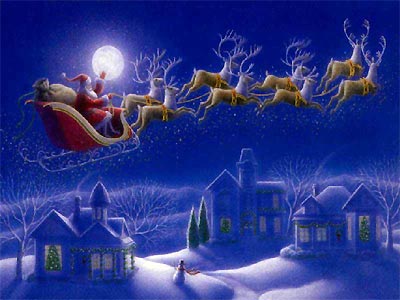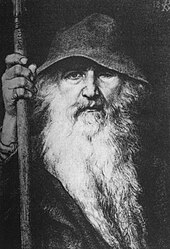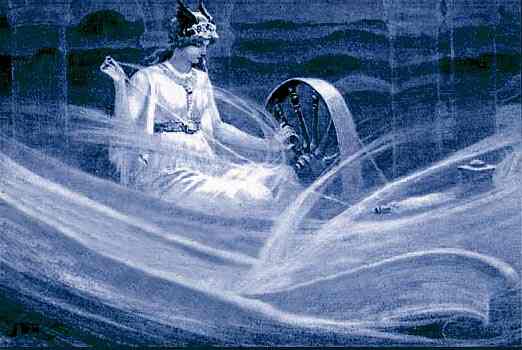 |
| Odin on his 8 legged horse (Image source: http://www.designboom.com/design/santa-claus-changing-design/) |
 |
| Santa with his flying Reindeer |
According to Wikipedia:
Yule or Yuletide ("Yule time") is a religious festival observed by the historical Germanic peoples, later being absorbed into and equated with the Christian festival of Christmas. The earliest references to Yule are by way of indigenous Germanic month names (Ærra Jéola (Before Yule) or Jiuli and Æftera Jéola (After Yule). Scholars have connected the celebration to the Wild Hunt, the god Odin and the pagan Anglo-Saxon Modranicht. Yule is also used to a lesser extent in English-speaking countries to refer to Christmas. Customs such as the Yule log, Yule goat, Yule boar, Yule singing, and others stem from Yule or Yuletide ("Yule time").
Yule is the modern English representative of the Old English words ġéol or ġéohol and ġéola or ġéoli, with the former indicating the 12-day festival of "Yule" (later: "Christmastime") and the latter indicating the month of "Yule", whereby ǽrra ġéola referred to the period before the Yule festival (December) and æftera ġéola referred to the period after Yule (January). Both words are thought to be derived from Common Germanic *jeχʷla-, and are cognate with Gothic (fruma) jiuleis and Old Norse. The word is attested in an explicitly pre-Christian context primarily in Old Norse.
Among many others the long-bearded god Odin bears the names jólfaðr (Old Norse 'Yule father') and jólnir (Old Norse 'the Yule one'). "
The origins of the Nordic Yule go back to a feast to honor the Norse God Odin, who among other things was the jolly God of Intoxicating Drink. The custom of the Yule Log or Yule Tree emerged from this winter festival as well.

The custom of Yule log varies from region to region. It's good to remember the primal importance of the gift of warmth and of fire to early people living in the cold North, the "flame at the Hearth" for ancient families. The Log may have originally been a large tree (Christmas Trees) brought to the house with great ceremony.
On Christmas, people light the Yule log placed in the hearth. The burning of the Yule Log brings good fortune for family and friends. After Christmas celebrations, a piece of the Yule log is retained to relight next year along with next year's log.
Origins of Santa Claus
......Margaret Baker"The appearance of Santa Claus or Father Christmas, whose day is 25th of December, owes much to Odin, the old blue-hooded, cloaked, white-bearded Gift bringer of the north, who rode the midwinter sky on his eight-footed steed Sleipnir, visiting his people with gifts. … Odin, transformed into Father Christmas, then Santa Claus, prospered with St Nicholas on the Christmas stage."

 St. Nicholas was a 4th-century Christian bishop
from Lycia (now in Turkey), who was known for his charity, and giving gifts to the
poor. In one notable story, he met a pious but impoverished man who had
three daughters. He presented them with dowries to save them from a life
of prostitution. In most traditional Iconic images, St. Nicholas is
portrayed as a bearded bishop, wearing clerical robes, an important patron saint of children, the poor, and
prostitutes.
St. Nicholas was a 4th-century Christian bishop
from Lycia (now in Turkey), who was known for his charity, and giving gifts to the
poor. In one notable story, he met a pious but impoverished man who had
three daughters. He presented them with dowries to save them from a life
of prostitution. In most traditional Iconic images, St. Nicholas is
portrayed as a bearded bishop, wearing clerical robes, an important patron saint of children, the poor, and
prostitutes.
The other mythos from which Santa Claus derives is much earlier, Odin, the ruler of Asgard. Odin was often
depicted as leading a hunting party through the skies, during which he
rode his eight-legged horse, Sleipnir. In the 13th-century Poetic Edda,
Sleipnir is described as being able to leap great distances, which some
scholars have compared to the legends of Santa's reindeer (and, of course, the Edda are from Finland, which once abounded with reindeer). Odin was portrayed as an old man with a long, white beard.
 |
| Odin (1886) by Georg von Rosen |
I read that during the winter, in some pagan folklore, children would place their boots near the chimney (and in the cold of a Nordic winter, it's a good place to put them), filling them with carrots
or straw as a gift for Sleipnir. When Odin flew by, he rewarded the
little ones by leaving gifts in their boots. Like traditions of the "Green Man" in England, in rural areas of Germanic
countries this practice survived despite the adoption of Christianity.
As a result, gift-giving became associated with St. Nicholas rather than the earlier Pagan god Odin. Only now we hang stockings by the chimney, and leave cake and brandy rather than carrots and straw.





































